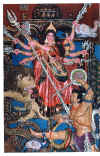| the-south-asian.com DECEMBER 2001 | ||
| about us contact us data bank past issues the craft shop the print gallery | ||
|
DECEMBER 2001 Contents Architecture Joseph
Allen Stein
Prem
Joshua Maharaja
Telecoms
& Software Value/Wealth Creators
Literature/Books 'It
was five past midnight Simplifying
Ramayana
Wharton
India Economic
Books
|
Page 2 of 2
Sakti - the Mother Goddess (cntd.) by Dr. Manoshi Bhattacharya
An
identifiable Sakti, distinct from the earlier fertility images, is
therefore over 4000 years old. Between 800 BC – 700 BC she appears to
represent a symbolic unification between the Aryans and the indigenous
population. She is as respected as any in the male pantheon but has not
superceded any of them. 500 BC, in India, sees the beginning of Buddhism
and Jainism, a surge in their popularity and a struggling Brahmanism.
200BC onwards the first Indian sculptures and evidence of image worship
appears. Was this an attempt at establishing some kind of permanence?
Perhaps the lay man needed a constant reminder of his heritage to prevent
him from straying. From this time onwards we see a change the world over.
The patriarchal gods seem to be relaxing their stern disciplinarian and
demanding roles and taking on a loving & forgiving image. Vaisnavism,
Shaivism and Shaktism make a beginning as being sects of Brahmanism. They
vie with each other to influence rulers and invading tribes offering them
a place within the Hindu fold, creating for them a mythical Indian origin
and thus justifying their presence in the land. 300 AD onwards the
powerful Brahmanical rulers the Guptas give the ancient brahmanical faith
a boost and we find an increase in Hindu temple art and architecture where
earlier it was mainly Buddhist and Jain. We see a revival of Shaktism now
with a surge in the, perhaps already existing, practise of Tantra. Human
mind cannot resist the power of the mysterious and Sakti throughTantra
influenced Buddhism, Jainism and even travelled abroad. By the 10th
– 11th century AD she is established as an independent deity
in India. Sakti
in other lands:
Sakti in Indian Mythology
Iconography The
most popular form of Sakti is that of Mahisasura Mardini. She is
represented usually standing with the right foot on her lion’s back and
the left on the Mahisasura’s shoulder. She has 3 eyes and the number of
arms range from 2 to 20. Today the 10 armed form is the most prevalent
among the devotees from Bengal. She has slender, well developed body, skin
the colour of gold, black curly hair and she is armed with the weapons of
the entire pantheon. Her garments are of red silk and her ornaments are of
gold and papyrus.The buffalo with its severed head lies at her feet.
Mahisasura, having emerged from the buffalo body, brandishes a sword and
shield. The goddess drives her trident into his chest. She is
accompanied by Saraswati, Laxmi, Ganesh and Kartik. An Iconic
representation of Siva is made denoting his omniscience. The
goddess may have a fearsome expression or one of benevolence. The
weapons she carries, are symbolic of the power granted to her by the
pantheon of Gods. Siva
Trident Vishnu
Discus Brahma
Earthen water pot
Varuna
Conch & a noose Agni
Spear Marut
Bow and arrow Indra
Thunder bolt and a bell Yama
Rod of fate Prajapati
Necklace Sun
Rays on her skin Destiny
Sword and shield Ocean
Garments, pearls & garland Visvakarma
Ornaments and axe Himavat
Lion Kuber
Wine cup Sesha
Serpent Noose ______________________________________
Copyright © 2000 - 2001 [the-south-asian.com]. Intellectual Property. All rights reserved. |
|
